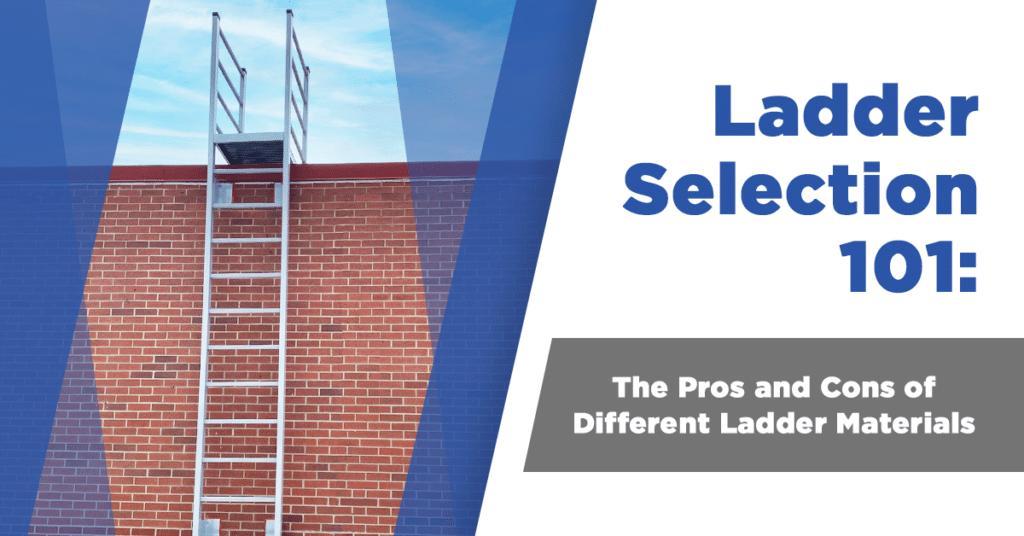Ladder Selection 101: The Pros and Cons of Different Ladder Materials

If you operate in the manufacturing industry or have workers who regularly access high areas, you’ll need to make employee safety one of your top priorities. According to the American Ladder Institute (ALI), it’s estimated that over 300 people pass away from ladder-related accidents every year.
To prevent any untoward incidents at work, it will be in your company’s best interest to purchase the top fixed ladders in the market.
Fortunately, there are several options when it comes to fixed ladders. Besides the differences in a ladder’s design, manufacturers offer pieces in different materials. Since each ladder material has its fair share of advantages and drawbacks, taking note of every type’s performance and purpose will enable you to find the best investment possible.
To help you narrow your choices down, we’ve listed the unique features of aluminum, steel, wood, and fiberglass ladders.
The Pros and Cons of Different Ladder Materials
Wood
For small business owners, wood is a popular choice since it’s affordable and readily available. Sometimes called timber ladders, wood ladders can be a bit heavier than other ladder materials. Be that as it may, this aspect makes the ladder sturdier and safer. As long as you take proper care of them, wood ladders can last a long time.
When dry, wood ladders are also a non-conductor of electricity. This feature makes them the top choice, together with fiberglass, for work that has electrical hazards. Despite this, wood ladders are not appropriate for all industrial or commercial environments as they are prone to rot, fungi, mold, and pests.
Pros:
● Feels solid and sturdy
● Inexpensive
● Non-conductive of electricity
Cons:
● Needs daily maintenance to avoid detoriration
● Not ideal for commercial or industrial applications
Steel
Steel is good to use in rough environments such as warehouses and industrial facilities. However, it’s important to note that steel ladders are not corrosion-resistant. If you plan to install it outdoors, you will need to have it galvanized, painted, or made with stainless steel to meet ladder regulations.
Pros:
● Suitable for heavy-duty work
● More affordable than fiberglass and aluminum ladders
● Rot-resistant
Cons:
● Heat and electricity conductors
● Vulnerable to moisture, corrosion, and rusting
● Requires regular maintenance
● Heavier than fiberglass and aluminum ladders
Fiberglass
Fiberglass ladders are the newest innovation of the ladder manufacturing industry. They don’t bend or weaken in hot temperatures. Additionally, they are lighter than wood ladders but are heavier and denser than aluminum ladders.
In comparison to aluminum ladders, fiberglass ladders are more difficult to work with because of their weight. Setting installation difficulties aside, the high cost of fiberglass also serves as one of its major disadvantages. However, if you need a non-conductive ladder, fiberglass can be your best option.
Pros:
● Non-conductors of electricity and heat
● Durable, doesn’t crack or splinter, built to last a long time
● Rot-resistant
● Has several color options
Cons:
● Not ideal for heavy-duty work
● More expensive
● Heavier than aluminum ladders
Aluminum
Aluminum ladders are very popular among industrial companies as they are durable, lightweight, and affordable. Moreover, you won’t have to worry about maintaining aluminum ladders because they are corrosion-resistant.
Pros:
● Affordable
● Corrosion-resistant
● Durable, won’t deteriorate in harsh weather
● Lightweight can be installed quicker
● Non-spark and non-magnetic
● High strength material suitable for heavy-duty work
Our Verdict
From the list above, it’s evident that the top choice is aluminum ladders. The advantages of aluminum ladders are tried and tested for generations. Since they are affordable and virtually maintenance-free, it’s no surprise that they’re the most popular type.
But before you start collecting options, you should take some time to evaluate your situation. Along with your local ladder regulations, you should consider factors such as its angle placement and purpose. Once you’ve addressed these concerns, you can start assessing which ladder material will work best for you.
Suppose your company requires heavy-duty work with ladders. In that case, you should opt for aluminum as it has an excellent strength-to-weight ratio compared to other ladder types with a high tendency to snap under excess pressure.
Select the Best Industrial Ladder
Choosing the right ladder material is essential to everyone’s safety. Depending on your purpose, some ladders are more or less fit for the job. As you do your research, see that the type of ladder you choose is durable, budget-friendly, and practical for your situation. Check out O’Keeffe’s lightweight, high strength, corrosion-resistant, OSHA and ANSI compliant industrial ladders for safe and high-quality aluminum ladders.